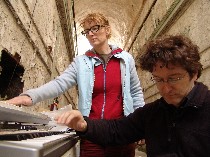 New York and a couple of Philadelphia shows I saw last week will just have to wait their turn, behind the big-name out-of-town team of Janet Cardiff and George Bures Miller, whose installation “Pandemonium” in Cell Block 7 at Eastern State Penitentiary opened Thursday night(image, Cardiff and her husband, Miller, working on “Pandemonium” in situ).
New York and a couple of Philadelphia shows I saw last week will just have to wait their turn, behind the big-name out-of-town team of Janet Cardiff and George Bures Miller, whose installation “Pandemonium” in Cell Block 7 at Eastern State Penitentiary opened Thursday night(image, Cardiff and her husband, Miller, working on “Pandemonium” in situ). 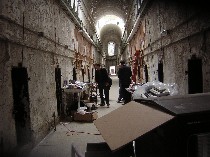 Little miss punctual was there on the stroke of 10, as usual, meaning I was the first to arrive, so I got the full attention of exhibit curator Julie Courtney and an ebullient Sean Kelley, the press officer for the penitentiary. The early morning light streaming through the temporary skylights into the cell block was spectacular, as Miller and Titus Maderlechner worked feverishly to get everything up and running. (Courtney said that Maderlechner was the “tone man.”)”The humidity is a problem,” Courtney said, explaining the last minute scramble to retune (left, the light in the cell block, along with Maderlechner left and Miller right talking to Cardiff, invisible except for her sneakers and jeans).
Little miss punctual was there on the stroke of 10, as usual, meaning I was the first to arrive, so I got the full attention of exhibit curator Julie Courtney and an ebullient Sean Kelley, the press officer for the penitentiary. The early morning light streaming through the temporary skylights into the cell block was spectacular, as Miller and Titus Maderlechner worked feverishly to get everything up and running. (Courtney said that Maderlechner was the “tone man.”)”The humidity is a problem,” Courtney said, explaining the last minute scramble to retune (left, the light in the cell block, along with Maderlechner left and Miller right talking to Cardiff, invisible except for her sneakers and jeans).
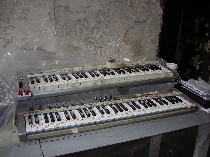 The men were working on the computer program, which triggers the solenoids that control each of the 120 tapping devices in 120 cells, connected by six miles of wire. With a percussion instrument in each cell, the cells become sound chambers and the cell block becomes a giant musical instrument–the largest in the world, said Courtney (right, the keyboard from the computer).
The men were working on the computer program, which triggers the solenoids that control each of the 120 tapping devices in 120 cells, connected by six miles of wire. With a percussion instrument in each cell, the cells become sound chambers and the cell block becomes a giant musical instrument–the largest in the world, said Courtney (right, the keyboard from the computer).
 A walk through the cell block revealed the local sounds in each cell in the context of the overall sound, which built to an explosive ending, the pattern reminding me of how July 4 fireworks build to the grand finale. It wasn’t hard to imagine a story line for the noises–enforced marches, pounding heartbeats, tapped communications and beaten frustrations (left, one of the instruments in a cell–a couple of oil drums and a drum stick between them).
A walk through the cell block revealed the local sounds in each cell in the context of the overall sound, which built to an explosive ending, the pattern reminding me of how July 4 fireworks build to the grand finale. It wasn’t hard to imagine a story line for the noises–enforced marches, pounding heartbeats, tapped communications and beaten frustrations (left, one of the instruments in a cell–a couple of oil drums and a drum stick between them).Courtney said that with the instruments in the cellblocks, it makes it seem that there are people in the cells, banging.
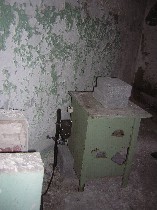 The Cardiff/Miller piece is more martial and thundering than the previous musical installation at the penitentiary by Timothy Nohe, “142 Ways to Mark Time” (see post). The sounds of Nohe’s reflective piece were taped on multiple loops and timed by a computer to orchestrate randomly, the range of noises including glass breaking, water dripping and footsteps–an imagining of what a prisoner would hear.
The Cardiff/Miller piece is more martial and thundering than the previous musical installation at the penitentiary by Timothy Nohe, “142 Ways to Mark Time” (see post). The sounds of Nohe’s reflective piece were taped on multiple loops and timed by a computer to orchestrate randomly, the range of noises including glass breaking, water dripping and footsteps–an imagining of what a prisoner would hear.
In Cellblock 7, Courtney said, architect John Havilland set back the catwalks, so the light would farther down into the corridor and cells on the lower level (right, another instrument, with drum stick beating on a chest from the prison cell; other instruments used pipes and other material found in the cells).
“Pandemonium” lasts 15 minutes with a 30 second break between the end and the beginning, said Cardiff, after walking away from Miller and Maderlechner. She didn’t seem to be needed during this phase of the preparation. She and Miller, who were both born in Canada, now live and work in Berlin.
Maderlechner also took a moment’s break from his feverish activity to talk. He said he was there for a little computer help. He also did the CD recording, which will come with the catalog. Courtney added that Richard Torchia wrote the catalog. It’s not clear to me whether the CD will be available on its own.
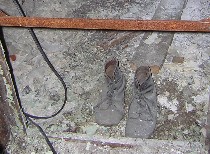 Compared to Cardiff walks, which include sound, words, stories and visual elements from the past and the present and the pretend, this piece seemed relatively simple, and more like a music piece than an art piece –in short, more Miller than Cardiff (see Roberta’s post and my post on Cardiff’s “Her Long Black Hair,” a walk through Central Park). Courtney said that as soon as she approach Cardiff about a piece at Eastern State, Cardiff declared that it wouldn’t be a walk, but something more like her “Forty-Part Motet” at P.S. 1., which incorporated the entirety of Spem in Alium by 16th-century English composer Thomas Tallis in a choral surround-sound experience, the noise and conversations of the gathering musicians as much a musical contribution as the Tallis motet (left, a rare visual element in “Pandemonium,” a pair of old boots).
Compared to Cardiff walks, which include sound, words, stories and visual elements from the past and the present and the pretend, this piece seemed relatively simple, and more like a music piece than an art piece –in short, more Miller than Cardiff (see Roberta’s post and my post on Cardiff’s “Her Long Black Hair,” a walk through Central Park). Courtney said that as soon as she approach Cardiff about a piece at Eastern State, Cardiff declared that it wouldn’t be a walk, but something more like her “Forty-Part Motet” at P.S. 1., which incorporated the entirety of Spem in Alium by 16th-century English composer Thomas Tallis in a choral surround-sound experience, the noise and conversations of the gathering musicians as much a musical contribution as the Tallis motet (left, a rare visual element in “Pandemonium,” a pair of old boots).“Pandemonium” is also surround sound, and it’s lovely in its own right. But as is the way with all commissions, you can’t always get what you want, and Philadelphia may have thought it was buying a Janet Cardiff/George Burres Miller piece when in fact it got a George Bures Miller/Janet Cardiff piece.
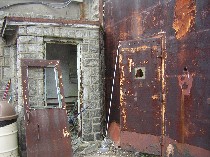 “Pandemonium” is the second installation at Eastern State organized by Philadelphia-based independent curator Courtney. She co-curated the first group of 14 art installations there–“Prison Sentences: The Prison as Site/The Prison as Subject,” a spectacular opening of the prison to public attention in 1995 (right, another view in the prison courtyard).
“Pandemonium” is the second installation at Eastern State organized by Philadelphia-based independent curator Courtney. She co-curated the first group of 14 art installations there–“Prison Sentences: The Prison as Site/The Prison as Subject,” a spectacular opening of the prison to public attention in 1995 (right, another view in the prison courtyard).









